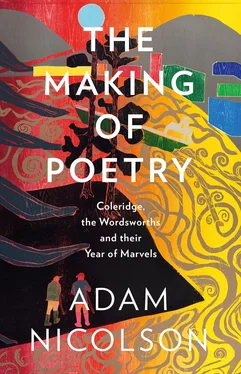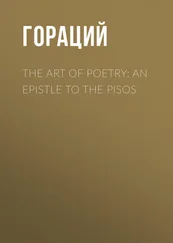In the early morning, when the leaves are grey with dew, the air in these oakwoods is as cool as a glass of cider. Cloud floats in the tops of the woods like another element, another sphere between you and the blue of the sky. Occasionally a big old pollard oak hangs its branches over the path. This is not wild country, not impressive in the way of grand or famous landscapes – far more intimate than that, and thick with the sensation that Wordsworth came to embrace in the course of this year. In some unused manuscript lines from 1798 he described how, after he had been walking for a long time in a remote and lonely place, away from people,
If, looking round, I have perchance perceived
Some vestiges of human hands, some stir
Of human passion, they to me are sweet
As light at day break or the sudden sound
Of music to a blind man’s ear who sits
Alone & silent in the summer shade.
They are as a creation in my heart …
Those words record the education of a mind, the sudden seeing of what had not been seen before. Man and nature fuse in those places. Human presence is no pollution in these woods, but the means by which a communal, multi-generational beauty has evolved, the co-production of man and the world of which he is a part. This is also part of the great gospel of interfusion of all in all and each in each to which this year is dedicated. When the wind is right, the bells of Holford church reach deep into the air between the trees.
Beyond the woods the world changes again, and the path emerges on to the tops, just above the treeline, or at least into one of the wind-sheltered nooks still surrounded by the wood but open at its upper edge. All above you, hill country: an occasional thorn, abused by storms or grazing mouths, and hung in the sunlight with gossamer threads, standing among the heather and gorse, the scrambled feathers of a young pigeon, a peregrine kill, a pair of buzzards mew-crying over the trees, tormentil in the acid turf.
Ahead, the lit outlines of the open-headed hills, a sun-drenched roof for the world. Over to the north, the Bristol Channel, with its two little islands, and the hazed Welsh mountains beyond them, to the east the milky distance of the low moors of the Somerset Levels, and on the far side the steady line of the Mendips.
It is a place, in that sunshine, to lie down and look: the woods on the lower slopes of these hills, the scatter of big farms and fields beyond them, multicoloured, green and tan, the shadowed hollows and dips in the farmland, the grey-blue plume of a distant bonfire smoking in the sun. Pies and doughnuts of woods dropped across the chequered fields.
Wordsworth loved to remember precisely how ‘in many a walk’, as he wrote later in his notebook, when they had reached this top and
reclined
At midday upon beds of forest moss
Have we to Nature and her impulses
Of our whole being made free gift, – and when
Our trance had left us, oft have we by aid
Of the impressions which it left behind
Looked inward on ourselves, and learn’d, perhaps,
Something of what we are.
The mind and the world were – ‘perhaps’ – part of one substance. To look outward was to look inward. The perceiving self was only the finest of strata buried in that doubly enveloping universe. The inner world was as vast as the outer. All the old impressions were ringing in his heart. Here was a place where the very movement of coming up and out allowed a movement down and in, the geography of the self becoming an inverse mirror of the material and external world.
It was true for Coleridge too. He described in his notebook how, when he forgot a name, only by not thinking of it could he remember it:
Consciousness is given up and all is quiet – when the nerves are asleep, or off their guard – and then the name pops up, makes its way and there it is! Not assisted by any association, but the very contrary – the suspension and sedation of all associations.
Sedation was one of the roots of understanding. Too much noise interfered with the mind’s engagement in the world. Only when you reduced the vibrations coming into your mind, and into your self, could things begin to seem as they were.
Many years later, on a return visit to the Quantocks, but filled with regret for the passing of time, Coleridge lay in reverie in just one such nook on the margins of wood and heath, easing himself back on to the perfect elastic mattress of the heather, but dreaming of love lost and love never to be had.
How warm this woodland wild Recess!
Love surely hath been breathing here;
And this sweet bed of heath, my dear!
Swells up, then sinks with faint caress,
As if to have you yet more near.
Eight springs have flown, since last I lay
On sea-ward Quantock’s heathy hills,
Where quiet sounds from hidden rills
Float here and there, like things astray
And high o’er head the sky-lark shrills.
This is where the wavering wind-songs of the Aeolian harp could soothe and seduce the mind. When the wind was right, a long, continuous and minimal music eased out of it. The sound belonged on empty heights like these – not the buffeting white noise of wind in the ear or in a chimney but something more hidden, tapered, as if the harp were releasing an element that was buried in it, or in the air. Deeper tones come from the heavier strings, along with witchery notes from the others, as if this were dream music or, as Coleridge says, the sound of the world singing.
Again and again, the year was filled with walks that followed this movement, the two poets up ahead, always a few dozen yards ahead, Dorothy following at their heels, always slightly behind. It is the deep psychic structure of the year, repeatedly drawing from these landforms, up from the settlements of the valley, through the combes and the oakwoods, on to the sunlit widths of the wide-ranging tops and then down again, back into the rowan and oakwood, as if into a bath of shade.
Nothing in the walk together would ever have been silent. Talk was the medium in which Coleridge swam. ‘He runs up and down the scale of language,’ Virginia Woolf wrote of him in her notebook,
stretching and suppling prose until it becomes pliable enough and plastic enough to take the most subtle creases of the human mind and heart. But while he disports himself like a great sea monster in his element of words, spouting, snorting, he uses them most often to express the crepitations of his apprehensive susceptibility.
You only have to read Coleridge’s own notebooks to feel that these hill-paths are still crackling with the crepitations of his apprehensive susceptibility. There is one place on the way down, in the little sub-hamlet of Over Stowey, or Upper Stowey as Coleridge called it, where an old well near the church had entranced him. Years later, from a time when he was abroad in Malta and in distress, he remembered gazing into its waters:
The images of the weeds which hung down from its sides, appeared as plants growing up, straight and upright, among the water weeds that really grew from the bottom/& so vivid was the Image, that for some moments & not until after I had disturbed the waters, did I perceive that their roots were not neighbours, & they side-by-side companions. So – even then I said – so are the happy man’s Thoughts and Things –
There, preserved in his memory, is a tiny fragment of Coleridge’s ebullient, ever-referential talk, perhaps to Wordsworth as they were coming down one day off the high tops.
It is his governing vision of the intimate co-existence of everything the mind shapes – the Thoughts – with everything that comes to him through his senses, the Things that seem so solidly present around us. The two are side-by-side companions. Thoughts and things are friends , and this for Coleridge is not a description of any sort of delusion but of happiness.
Читать дальше












